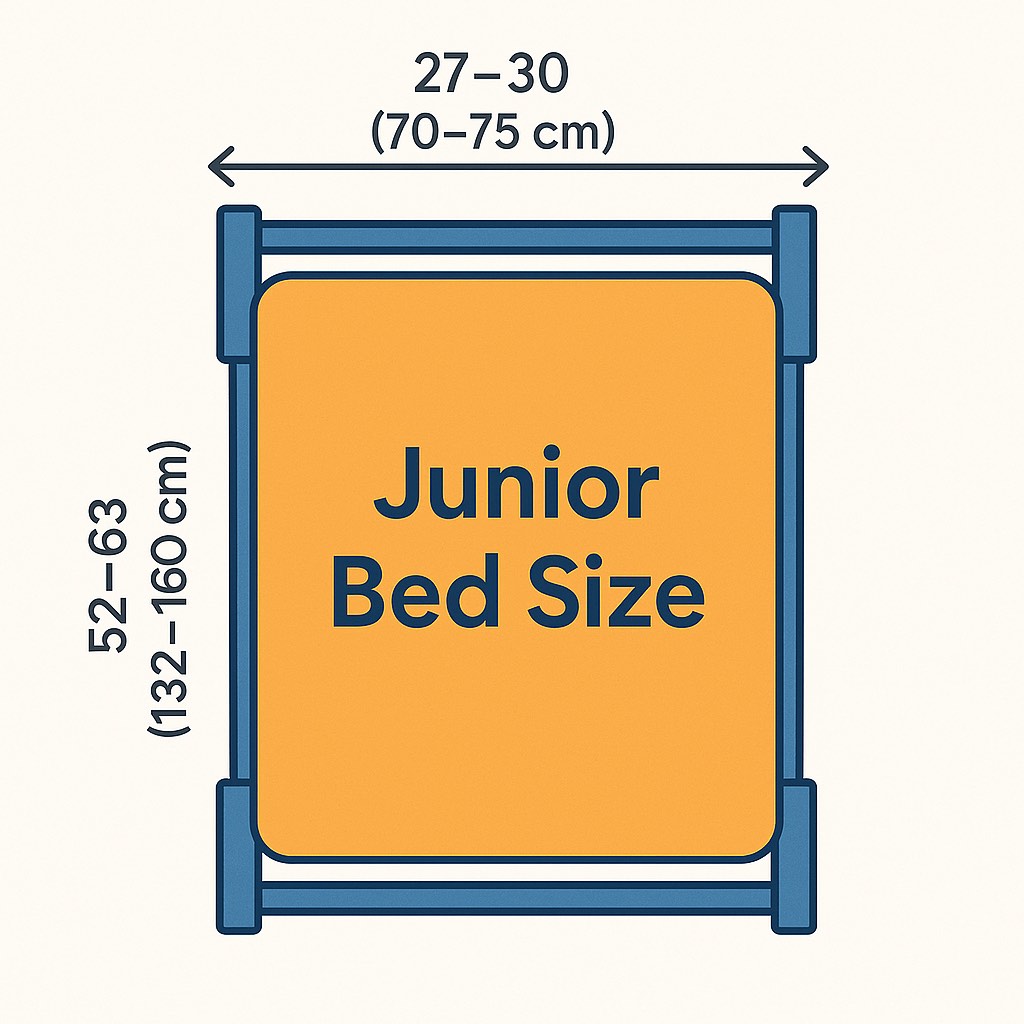Junior Bed Size – The Perfect Transition
Ready for the next step? Junior bed size can be the solution!
Outgrowing the crib is a huge milestone for both kids and parents—but what comes next? A Junior bed is the perfect in-between solution, offering just the right mix of safety, comfort, and fun.
In this guide, we’ll explore everything you need to know about Junior bed sizes, who they’re best for, shopping tips, and why they make the transition to “big kid” sleep so much smoother. Let’s dive in!

📏 Junior Bed Size Dimensions
Typical Junior Bed Size in US:
Mattress: 27″–30″ wide × 52″–63″ long (70–75 cm × 132–160 cm)
Frame: Slightly larger depending on style and design.
Note: In the U.S., many “junior beds” are simply adapted toddler beds or smaller twin beds.
🌍 Dimensions by Country/Region
Junior beds are not fully standardized worldwide, and their dimensions can vary slightly depending on regional preferences and manufacturing norms. Here’s a breakdown with dimensions and alternative names in different countries/areas:
| Country/Region | Typical Junior Bed Size | Notes |
|---|---|---|
| United Kingdom | 27″ × 55″ to 30″ × 63″ (70 cm × 140–160 cm) | “Cot beds” often transition into junior beds; junior mattresses are common. |
| Australia | 27″ × 55″ (70 cm × 140 cm) | Similar to UK sizes; junior beds often called “toddler beds.” |
| Europe (general) | 27″ × 55″ to 31″ × 63″ (70–80 cm × 140–160 cm) | Many feature extendable junior beds that grow as the child ages (common at IKEA and other brands). |
| Scandinavia (Sweden, Norway, Denmark) | 27″ × 63″ (70 cm × 160 cm) | Very popular to use extendable beds; adjustable from toddler to early teen. |
| Japan | 27″ × 47″ to 28″ × 55″ (70–72 cm × 120–140 cm) | Smaller junior beds are common due to limited space. Co-sleeping traditions also affect bed sizing. |
👧Who is Junior Bed Size Best For?
Toddlers and Young Children (ages 2–7 years)
- Ideal for kids who have outgrown the crib but aren’t ready for a full twin bed.
- Provides security and comfort with optional side rails.
✅ Pros of Junior Beds
👶🏻Perfect Transition:
Helps kids adjust from crib to a “big kid” bed without feeling overwhelmed.
🏠Space-Saving:
Smaller than a twin bed, great for smaller bedrooms or shared spaces.
✅Safety Features:
Often come with guardrails and are lower to the ground.
🎨Fun Designs:
Available in themed designs like race cars, princess castles, and more.
💸Cost-Effective:
Generally cheaper than larger beds.
❌ Cons of Junior Beds
🤸🏻♀️Shorter Lifespan:
Most kids will outgrow a junior bed by around 6–7 years old.
❌Limited Availability:
Not all stores or brands offer junior beds.
📏Mattress Sizing Issues:
Some sizes are less standardized, which can make finding replacement mattresses or sheets a little tricky.
🏠 Bedroom Space Needed
Minimum recommended space for a junior bed:
7 ft × 6 ft (2.1 m × 1.8 m) area to allow comfortable movement around the bed.
Fits well in smaller children’s rooms, apartments, or shared sibling rooms.
🕰️ History and Fun Facts
Origins:
Junior beds became popular as parents sought safer and more age-appropriate options between cribs and full-size beds.
Fun Fact:
In Scandinavia and parts of Europe, junior beds have long been standard, often adjustable to “grow” with the child.
Safety Evolution:
Early versions were simply smaller twin beds, but modern junior beds now focus heavily on safety and fun designs to make the transition exciting for kids.
🛒 Junior Bed Size Shopping Guide
🧩 What to Look For before buying
- Sturdy Construction: Solid wood or durable metal frames are best.
- Guardrails: Essential for preventing nighttime falls.
- Non-toxic Finishes: Particularly important for younger children.
- Easy Assembly: Look for beds with clear instructions and minimal tools needed.
- Matching Mattress: Ensure mattress fits snugly—important for safety and comfort.
- Style and Theme: Pick something that matches your child’s personality to make bedtime exciting!
🏷️ Popular Types
- Classic Junior Beds: Simple, minimalistic designs.
- Convertible Beds: Can extend into twin beds later.
- Themed Beds: Cars, castles, cartoon characters, and more.
- Adjustable Length Beds: Extendable beds that grow with your child.
💡 Pro Tips for Buying a Junior Bed
- 📏 Double-check measurements: Junior bed sizes vary slightly, so measure your space and the mattress before buying.
- 🛡️ Prioritize safety features: Guardrails and a low frame are key for young children.
- 🛍️ Think ahead: Choose a bed with a longer usability period (e.g., adjustable beds) if you want more value.
- 🌿 Eco-friendly options: Look for certifications like GREENGUARD Gold or FSC-certified wood.
- 🛌 Involve your child: Let them help pick the design to build excitement around the transition.